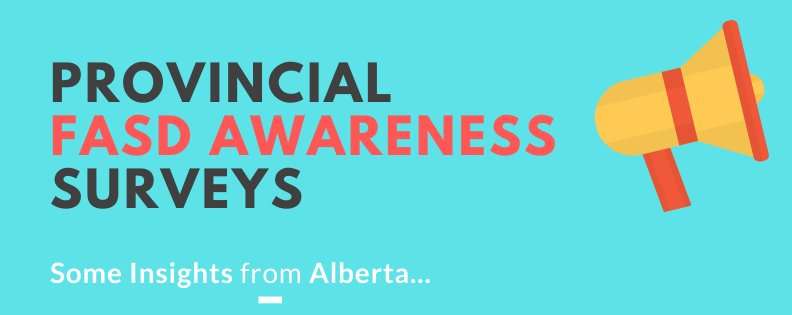How our “Examining the Measurement Properties of What Albertans Know about Fetal Alcohol Spectrum Disorders Survey” project came to be.
Submitted by Kathleen Kennedy
Setting the Stage
In Spring 2018, both Dr. Bulut and myself applied for a SAGE Secondary Data Use Grant from PolicyWise for Children & Families, a not-for-profit research organization located in Edmonton, Alberta. When we developed our proposal, I wanted to propose a project that would not only allow me to explore my clinical and research interest in Fetal Alcohol Spectrum Disorder (FASD) but also be able to capitalize on Dr. Bulut’s strengths in the area of educational measurement and expand my knowledge base in this particular content area. To do so, we proposed a project that would allow us to complete a secondary data analysis on FASD awareness survey data in an effort to contribute a new understanding to the literature in measuring and understanding public awareness of FASD.
A secondary data analysis involves using data that was collected for another purpose by other people or institutions, such as researchers or government organizations. In this case, we used a portion of the data from the 2017 What Albertans Know about Fetal Alcohol Spectrum Disorders survey (FASD Survey) conducted by the Population Research Laboratory (PRL) at the University of Alberta. Fortunately, we were successful in our application and our work began!
Goal of the Project
Researchers typically measure FASD awareness through surveys. Data generated from FASD awareness surveys, like the one used in our study, are often used to inform educational campaigns that aim to communicate to the general public the dangers of consuming alcohol while pregnant.
There are a number of surveys out there that have been used to measure FASD awareness. Although some of these surveys are similar, many of them differ in terms of the types of questions they ask. For example, some surveys may state, “Alcohol use at any point during pregnancy can harm the fetus” and participants are asked to respond on a five-point rating scale from “strongly agree” to “strongly disagree.” However, other surveys will use the same statement but participants are asked to respond by selecting either true or false.
This is how our study came to be. We realized there are a number of different tools and questions surveys use to try and measure the same thing: FASD awareness. We wanted to evaluate how effective these tools were in getting an accurate measurement of this concept. Accuracy, in this context, refers to whether or not a survey is reliable – whether it is able to consistently measure FASD awareness in a given population.
The Survey
The 2017 FASD Survey was designed to measure FASD awareness, which we defined as the knowledge and attitudes individuals have about the disorder, how it occurs, and who is responsible for preventing it. The survey data we were given by PolicyWise consisted of 1,205 responses from participants. The survey itself consisted of 21 questions related to general knowledge about FASD, personal beliefs relating to FASD, and attitudes concerning prevention of FASD. We took the questions from the survey and grouped them into three sections:
Support and Prevention
Nine (9) questions that targeted:
- identifying who is responsible for supporting a woman not to consume alcohol during pregnancy;
- the best methods through which FASD can be prevented.
Beliefs about FASD
Four (4) questions that targeted:
- Challenges challenges individuals with FASD might experience (i.e., trouble with the law, learning difficulties).
General FASD Knowledge
Eight (8) questions that targeted:
- a variety of FASD-related information (i.e., the impact of use, amount, and type of alcohol on the development of the fetus);
- general awareness of FASD.
Key Findings and Recommendations
We found several interesting findings (outlined below) that helped us to make recommendations to improve the development of future surveys.
Finding 1: The pattern of results tells us that the majority of participants were able to answer the FASD Survey questions correctly, suggesting the questions in the General FASD Knowledge were too easy for most participants. As a result, this survey section can only measure lower levels of general FASD knowledge, such as the existence and causes of FASD.
- Recommendation: The General FASD Knowledge section of the survey would benefit from having additional, more specific questions to measure individuals’ knowledge of FASD more precisely. For example, one of questions asked participants to respond “true” or “false” to the following statement: “Alcohol use during pregnancy can lead to life-long disabilities in a child.” To add complexity to the survey, additional true or false items could be added to specifically target what domains can be impacted for an individual with FASD (e.g., mathematics, justice, housing, employment). Additional questions might also be added that address more complex FASD concepts. Adding items like these would allow researchers to measure higher levels of General FASD Knowledge.
Finding 2: In general, males and females responded to some survey questions differently. Female participants appeared to answer questions correctly more frequently than male participants. This could suggest a larger lack of FASD awareness among male participants. This pattern of results is not surprising given that prevention messages, such as those used in educational campaigns, tend to focus on women of childbearing age. Therefore, females may have received more information on the areas of FASD awareness this survey targeted and, as a result, responded accurately more often than their male counterparts.
- Recommendation: Questions in which gender-based differences were observed should be revised to eliminate gender bias. To eliminate the gender bias, future surveys could consider re-wording items so they are applicable to both male and females. For example, one item on the survey asked respondents to identify the best way to prevent FASD. The largest gap observed between male and female participants was that females were more likely to select the response option, “no alcohol use while trying to get pregnant.” To eliminate the bias in this item and to make the item applicable to both males and females, the response option could be re-written to read, “no alcohol use while couples are planning to get pregnant.” This shift in language has the potential to eliminate language bias so that both males and females see preventing FASD as a shared responsibility.
Based on our analysis, the FASD Survey is a suitable tool for measuring and understanding the constructs related to Albertans’ FASD awareness. However, the survey needs further improvement, as recommended above, in order to make valid conclusions regarding FASD awareness in Alberta.

We are grateful for the opportunity to share our research with CanFASD and we would like to thank PolicyWise for Children & Families for funding this research.

Kathleen Kennedy is a third year PhD student in the School and Clinical Child Psychology Program (SCCP) at the University of Alberta. Kathleen’s research interests include the assessment of cognitive abilities, the assessment of culturally and linguistically diverse (CLD) students, and academic achievement of individuals with neurodevelopmental disorders, such as Fetal Alcohol Spectrum Disorder (FASD).

Dr. Okan Bulut is as Associate Professor of educational measurement and psychometrics as well as a member of the Centre for Research in Applied Measurement and Evaluation (CRAME) at the University of Alberta. Dr. Bulut’s primary research areas are centered on educational and psychological measurement, evaluation, psychometrics, and technology integration in education. Specifically, his current research interests include psychological testing, survey design, computerized assessments, automated feedback. Generation, and statistical programming using the R programming language.

